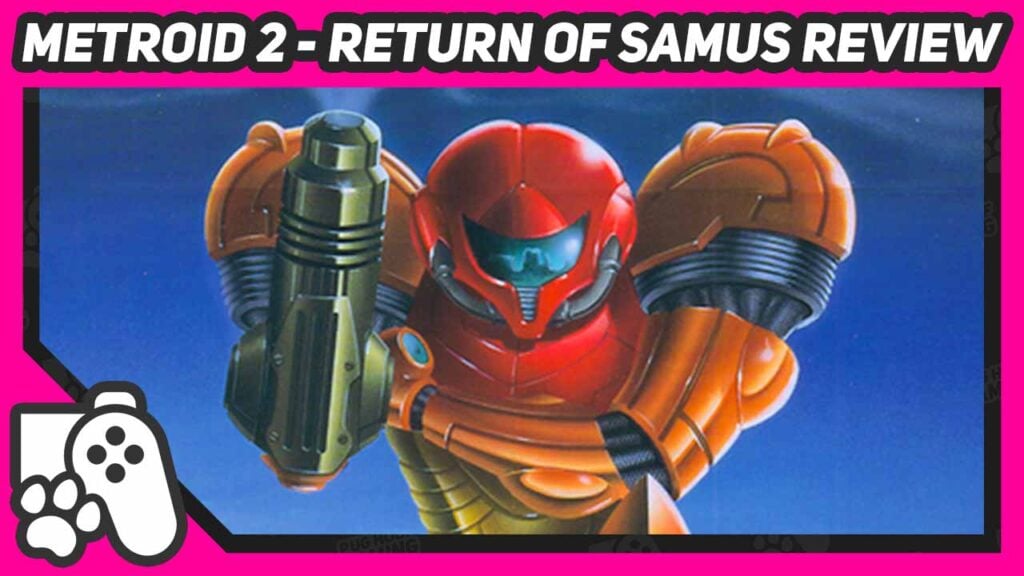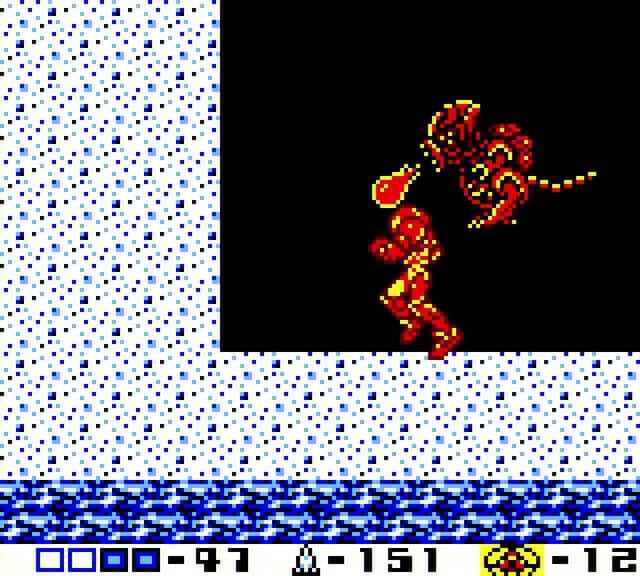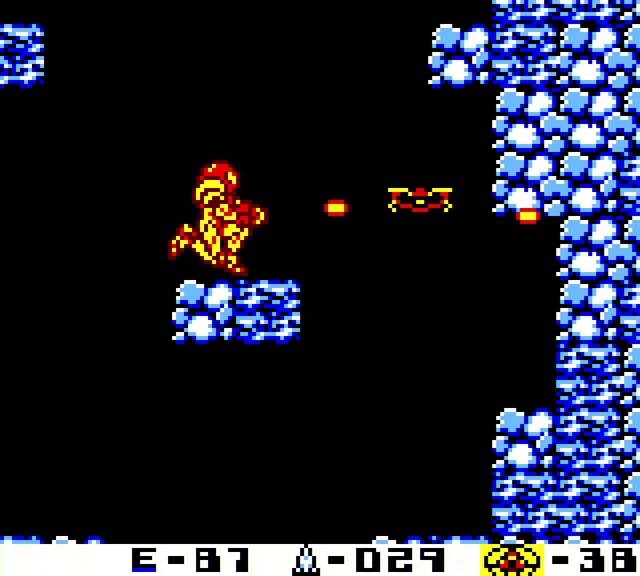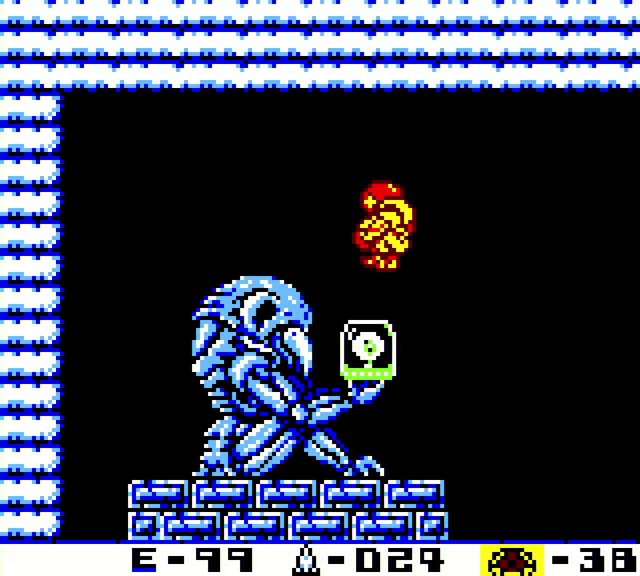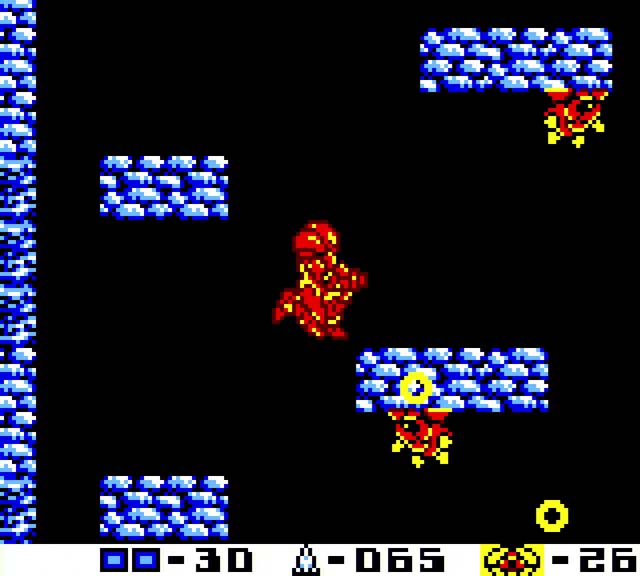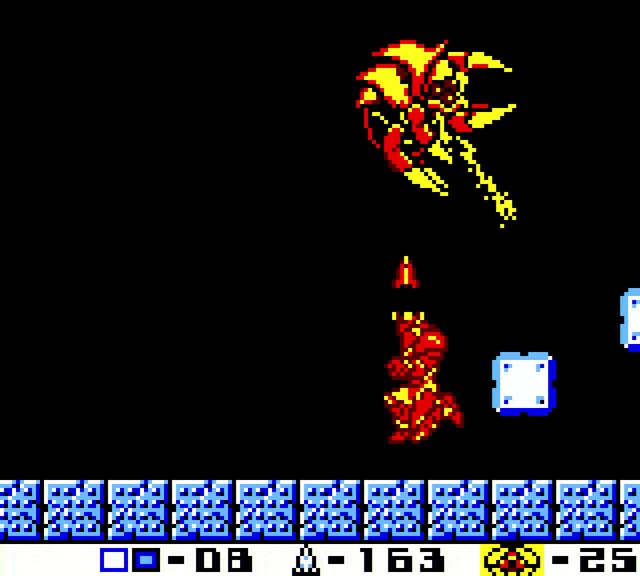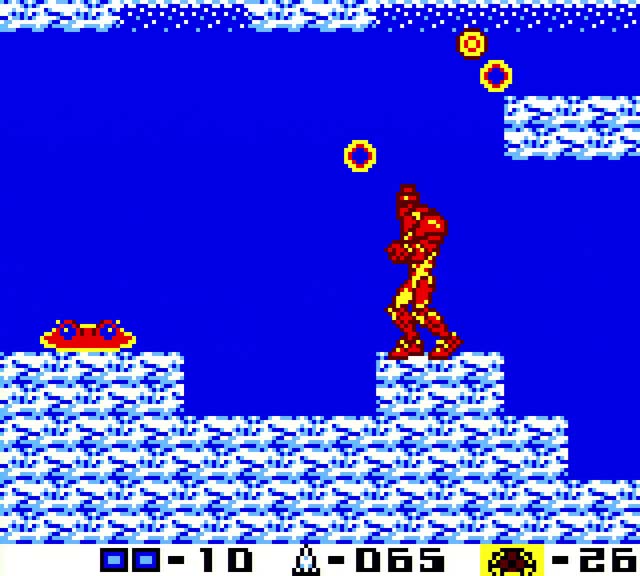The Space Pirates of Zebes have been defeated, but the threat posed by the deadly lifeforms known as Metroids is still a real one. It falls upon the Bounty Hunter, Samus Aran to travel to their home planet of SR388 under the orders of the Galactic Federation. Her mission: To exterminate every Metroid on the entire planet and ensure that the species is extinct and will never again be used for nefarious means.
Released in 1991, five years after the Japanese release of the original NES title, Metroid II: Return of Samus shifts the series to Nintendo’s portable Game Boy. Releasing a canonical sequel to a home console game was in stark contrast to the majority of other Game Boy instalments of titles previously released on the NES. Rather than come up with a cut down portable version and call it a side story, Nintendo’s R&D1 team instead use the strengths and weaknesses of the portable system format and came up with a sequel that not only fits in the realm of portable play but also tidies up a lot of the issues with Metroid and takes the idea of exploration and player growth into a different direction.
Return of Samus’ premise is simple: Explore SR388, find Metroids, destroy them, explore further. However, while the original game creates barriers through the requirement of particular items or skills, the majority of Metroid II’s progression is locked behind how many Metroids you’ve killed. An ever-present counter resides at the bottom of the screen, beginning at forty. Meanwhile, some areas of SR388 are filled with a dangerous liquid that prevents further progress – Defeating a set number of Metroids in each area will cause an earthquake that drains this liquid and allows for further progress. Unfortunately for you, the Metroids on this planet are able to evolve into increasingly far more dangerous forms. While you’ll encounter their better-known larvae stage, you’ll soon encounter the larger Alpha form, a Gamma form that packs a lightning attack, the fire-spitting Zeta Metroid form, and the extremely deadly Omega Metroid.
This Metroid-busting mechanic means that exploration and progression are completely different to any other Metroid title, apart from this game’s 3DS remake, of course. The entire game is separated into mini-areas, temporarily partitioned off by this unknown liquid, and while the Metroid series is known for backtracking, here it is not always necessary. In fact, it’s possible to obtain all of the available items and upgrades from each separate area before progressing further. This seems to be an intended concession towards this being a portable game and made for short bursts of play. In splitting up SR388 this way, it is more than possible to make satisfactory progress in a relatively short play session, especially as save points are never too far away.
Yes, you heard right – The dreaded passcode system from the Western editions of Metroid is gone and replaced with a helpful save battery system. Each area has a Save Station, just stand on it, press Start and your game progress is safe for another day. Hooray!
Metroid 2 Return of Samus Review – Gameplay Progression
Back to the subject of gameplay progression, and while some people might bemoan the way SR388 is handed to the player in smaller portions – I honestly quite like it this way. The player is never too overwhelmed by too many routes and pathways, and I feel there’s enough of a leash to get a little lost, but not for too long – Which is perfect if you’ve only got limited playtime. Unlike the first Metroid, there aren’t a great deal of unfairly hidden passages, either, but there are plenty of hidden items to be found if you have the time to look. Plus, there’s nothing really stopping you from backtracking if you really feel like you missed something, although once again there is no map to help you out – So you’re relying again on making one yourself or finding one online. However, this is nowhere near as much an issue as it was with the previous game. Ultimately, Return of Samus pushes you further and further underground, so once you realise that 90% of the time, you need to go down until you reach the deadly liquid, it’s not too difficult to figure out what you need to do next. Also, if you’re running out of health or missiles, as well as the standard farming of enemies for pickups, each area has a couple of pickups that can be used to completely fill up your energy and missile reserves – It definitely helps to try and remember where these pickups are, especially as they’re not always out in the open.
In terms of abilities, Samus starts off with just the Morph Ball and her standard blaster. The Long Beam is the only upgrade from Metroid 1 to not return, but brand new upgrades include the Spring Ball, which gives the Morph Ball a jumping ability, and the Spider Ball debuts here which can allow the Morph Ball to cling to walls, perfect for item hunting. Two new beam pickups appear, the Spazer and the Plasma Beam, which give Samus more offensive capabilities and the final new item is the Space Jump – A tricky-to-master upgrade that can be used to keep Samus in the air indefinitely by repeatedly spin jumping. The Screw Attack can be added to this move when found, to make an incredibly deadly weapon of Samus’ jumps.
Clearly, this game was designed from the ground up, to be played on the Game Boy. Samus’ sprite is surprisingly large and takes a considerable amount of screen real estate, so there isn’t a great deal of room around the player. Combine that with the fact that for the majority of the game you’ll be in tight, subterranean tunnels, and you end up with a game that provides an even more claustrophobic atmosphere than the original NES title. It’s a good-looking Game Boy game too, especially for one released relatively early in the system’s extended lifespan, and apart from the lack of colour, it’s definitely an improvement from the previous instalment. However, where the graphics fall greatly, is the lack of variation between areas – Unfortunately, most of the environment looks identical, which can cause problems with navigation, especially without an in-game map.
However, there are some neat little touches throughout SR388. Every now and then you run into the moulted husk of a Metroid – A clever warning that a Metroid is nearby and waiting to ambush you. Sometimes you’ll even see Metroids mutate in front of your very eyes, which absolutely brings you a sense of dread. But, sadly, fighting these various Metroid forms all revolve around hitting them repeatedly with missiles, with no actual strategy involved. Also, as you get further and further into the caverns of SR388, it feels like you’re encountering fewer standard enemies but more Metroids, which would imply that the titular foes are acting as the apex predators of this planet, but it does mean that the later areas feel a little sparse, and dare I say it – A little dull.
Interestingly, this is one of those games that has its own pre-defined palette when used with a Super Game Boy. That doesn’t mean it has more than the usual 4 shades, ala Donkey Kong ‘94, it just means that Nintendo sets the Super Game Boy to use this particular palette when Metroid II is played. It’s a little bit garish, but it does the job if you’re bored of the usual shades of grey or green. There were rumours of a DX version of the game being in development for the Game Boy Color, but this was not to be – However, the system does have its own default palette. All of the footage for this review is being taken via the Game Boy Player, which uses the same palettes as the Game Boy Color, and it’s definitely the best original way to play the game in my opinion. In 2019, a hack for the game was released that offers a colourisation of the game for the Game Boy Color, and from what I’ve played, it’s very well done indeed. But, even if you’re just settling for playing in good old fashioned monochrome – The graphics are still nice and clear with excellent separation between sprites and environmental elements.
Audio is also very well done and follows on nicely from the sort of pieces heard in Metroid 1. While there is once again a more upbeat main theme that’s played initially, as you delve deeper underground there is a larger emphasis on moody, unsettling music. Aside from the more aggressively menacing music that plays during the various Metroid encounters, you’ll spend a lot of time exploring while being backed by some very otherworldly sounds. It’s not so much music, as mostly silence, punctured by the occasional trickle of sounds, and it definitely helps to convey that mood of going deeper into this unexplored planet – All the while, hearing the shuffling of Samus’ footsteps. The sound effects are quite abrasive by comparison, but really that’s more due to the limitations of the Game Boy rather than a failure on the developers’ part. It absolutely sounds unlike any other game in the series, mostly for the better.
If you hadn’t noticed, Metroid II is a very unique instalment in the series. Like many of Nintendo’s second games in a franchise, Return of Samus shakes things up and tries to do things differently. It’s a very deliberately designed game, with every piece created in such a way, to fit the Game Boy and the way that system is played. That undoubtedly comes at the cost of some of the freedom that the series is known for, but I like this game for what it is. It’s an easier game than its predecessor, that’s for sure – The controls feel better, enemies don’t take excessive amounts of hits to kill, and you don’t have to spend as much time farming for health and missiles.
Aside from this game’s ending being a pivotal narrative point for the non-Prime series, I would say Return of Samus is absolutely worth playing. Whether it’s worth skipping for its 3DS remake, Samus Returns is a question for a future video, but I don’t think this game gets its proper dues. Metroid II is a damn good Game Boy game, and I think I prefer this to the original NES title. If a newcomer asked me what Metroid game to play first, I would honestly mention this one – The difficulty is placed just about right, if a little on the easier side, while the approach to doling out game progress in a piecemeal fashion is quite friendly to new players.
It’s a cut-down exploration-led adventure that delivers the majority of what you expect from a Metroid game, just in a smaller package. Lack of in-game map functionality aside, there’s nothing that would trip up someone playing this in 2021. I found myself enjoying my playthrough of Return of Samus much more than I thought I would, and that’s what this series of reviews is all about.
Please do let me know what you think of my Metroid 2 Return of Samus review in the comments, and I will see you very soon for a review of Samus’ 16-bit debut in Super Metroid.
